This is a compilation of the designer diary entries posted in the Pendulum Facebook group. They are listed here in chronological order, with the most recent entry at the top.
***
July 16: Intuitive Play and Untimed Play
Travis has a few more stories about the design process for Pendulum! Here they are:
Intuitive Game Play
One of the biggest turning points in the design of the game came a couple years into its existence. Up to that point it had been a bit of a ‘VP salad’ game, and even a ‘resource salad’ game as well. Cards and action spaces could give you any basket of goods or victory points. There was clear iconography for these, but it was up to the players to look at each card or action space to see what all it gave you. While this provided for more options and complexity, it wasn’t intuitive to make sense of in real time, and players could feel lost and overwhelmed. Even if you felt like you made some strong plays, you didn’t necessarily feel like you developed a clear strategy over the course of the game.
This really crystallized for me after one particular playtest, but it wasn’t as clear as it sounds in the feedback. It mostly came through in players feeling that the game was good but not great. Players moved pieces around a board for an hour or so, but things were a bit of a blur, and they weren’t sure what the ‘story’ of their game was afterwards. I worked back through the game to add some clear strategic pathways. Each resource was tied to a Victory Track that it was most effective at obtaining – Military for Power (as most Provinces can give Power), Culture for Prestige (via the Stratagem card that gives Prestige), and Gold for Popularity (via action spaces that give Popularity). These relationships were also color-coded into the game (i.e., icons for Military and Power are all red), so that they became instantly recognizable to players. This gave players a way to pursue different strategies on a more intuitive level, and to be able to adjust their focus quickly throughout the game without having to read through details of several different cards or action spaces.
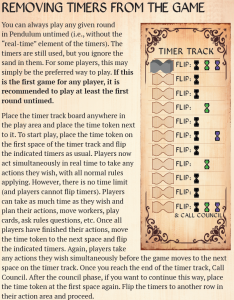 Untimed Play
Untimed Play
Once the game was signed and we moved into development, we saw a big divergence in early playtest feedback. Some groups grasped the flow of the game quickly and loved it, while some groups just couldn’t settle in and play the game comfortably once the timers flipped. We realized learning how to play the game in real-time just didn’t work for some people, so we would need to develop a way to potentially play through part of the game ‘untimed’. The core mechanisms of the game are generally not too complicated. The hurdle for some gamers is just getting used to executing them before jumping into real-time, which is totally understandable. The point of the game is to challenge players to use their time to figure out their best play, not to figure out how the rules work.
Initially we worked up an entirely pre-programmed first round. This walked players through the mechanics of taking different actions with no time pressure. However, it removed any agency from players, so it proved to be less effective as a teaching tool. There’s just no replacing that moment in a game where you’re thrown into the deep end and have to actually start making choices. So, after building out numerous meticulous scenarios to cover the first moves for any combination of players and characters, we tossed it all out for a much simpler and more effective approach (like so many aspects of game design, simpler is usually better!).
Now, the optional Timer Track in the game marks off the exact order the timers would typically flip in a game. Players can thus ignore the sand in the timers and play the game in its entirety without any limits on the time they take to decide their actions at each step. This approach makes a small trade-off, as there is still something like ‘real-time’ decision making as players take simultaneous actions after flipping a timer. But having unlimited time to take and resolve actions really lowers the stress level. Plus, the simultaneous actions are a step closer to real-time play, so the change is less jarring once players jump into real-time mode. Moreover, we realized there’s no reason a group can’t simply play the entire game in this ‘untimed mode’ if they prefer.
July 15: Early Playtesting and Development
We’re done with all Pendulum reveals (except the reviews, which will begin on July 29, a week before the preorder begins), but I have a few more stories to share from Travis. Travis will be participating in some virtual Gen Con events in case you have questions about these stories (he’s also usually available in the comments here).
Okay, the rest of this is from Travis:
Playtesting Solo
Designing a real-time strategy game presents plenty of unique and difficult challenges. When designing a game that is not real-time, you can do some testing by yourself as the designer, taking ‘turns’ and hopping between seats of different theoretical players. This is of course not the same as a playtest with other real players, but it can still work out a few basic kinks. But with a real-time game, even this simple level of testing becomes incredibly difficult and downright impossible for most aspects of the game. Taking ‘turns’ in order by yourself just doesn’t work in a game that has no turns.
Eventually, I figured out that rather than trying to simulate one game with multiple players, the best way to test was to play multiple solo games. I could play around with different aspects to simulate other players, like just tossing out a few neutral workers and spontaneously moving them around at different points in the game. This approach helped, but it still took longer than usual to iterate through early versions of the game, and probably lengthened the development time throughout every stage of the game’s design, all the way up to the last rounds of blind playtesting.
Streamlining Play
After getting over the initial bumps of my own learning curve as a designer, I had a long journey of streamlining a lot of the mechanisms within the game. This is of course crucial for any well-designed boardgame, but it’s only amplified for a real-time game. You simply cannot overestimate how hectic a real-time strategy game feels for players in the moment. There is limitless potential for players to forget to do some action or step in the game. All actions that players take need to be intuitive and as simple as possible in terms of both execution and iconography, and all steps involved need to be tightly wound together. Once I went into development with Jamey and Alan we continued to hammer out some of the mechanisms.
For most of the game’s life, players placed workers on an action space and waited for the timer to finish to then perform the action. The idea was that the worker had to spend time ‘doing’ the action. However, at the moment players picked up a worker they were always faced with the decision of what to do with the worker next as well. This caused two different important steps in the game to collide into each other in one moment – performing the action the worker just completed and deciding what action to do next with the worker. Players sometimes completely forgot to even take the action the worker had just spent so much time completing. So, we made the simple adjustment of allowing players to take an action when their worker first becomes locked by a timer. When that worker comes free the player can just focus on where to reassign the worker at that moment, and they’re not distracted by having to complete a different action at the same time.
July 14: Did Jamey just throw us the mother of all solo-mode curveballs?
Over the years we’ve made many different Automa solo modes for Stonemaier Games and each of the games has presented its own unique challenges.
Viticulture was tough, because it was our first Automa. The area control and unit movement of Scythe gave month-long headaches. Negotiation and semi-cooperative elements in Between Two Cities was challenging to say the least and Charterstone with its constantly shifting rules and configurations were unique hurdles to overcome with an Automa system that had to be simple enough to be OK for people who usually do not like bots.
For Pendulum, though, Jamey threw us the mother of all curveballs: He asked us to do an Automa in a real-time game: Not only will the player be under time pressure to handle their own actions they should also spend time implementing the actions of an Automa.
To show that we weren’t scared of the challenge Jamey gave, we decided to add not one, but two Automas for the player to handle 😊.
It’s not bad, actually
Well, it’s not bad, actually. Pendulum is not tight on time in the way that many other real-time games are. You don’t scramble frantically around and so we could get away with the player spending some time on the actions of the Automa, but it was clear that the time that could be set off for this would be extremely limited.
2 for the price of 1
As said, we decided that we wanted 2 Automas if possible, which ramped up the challenge, but we could lower the cost of that by merging the two Automas into one during the real-time phases, so that the game works as if there’s only one. Let’s call this combined pair the AuTwoma.
We streamlined the AuTwoma to make its core job simple: Prevent the player from doing what they want – the cardboard equivalent of a linebacker. It does this by moving workers around to block action spaces and occasionally flip a timer to prevent the player from dragging out the game and do extra actions.
It was crucial that the human player shouldn’t have to constantly check whether a sand timer had run out or something like that to know when to do an action for the AuTwoma. That would be extremely distracting and error prone in a real-time game.
The system we went for, triggers the AuTwoma when the player removes a worker from the board. The most common thing it does is to move a worker. When it does so, it randomly chooses one of two action areas using a single icon on a card. After that there’s always only one specific move to make and so it’s very fast for the player to perform the action.
2 for the price of 2
When a real-time phase is over and the game moves to the council phase the Automas cancel their real-time alliance and work as two separate players. They score victory points separately, participate in voting separately, etc.
Since the game is not real-time at that point, it’s not a problem to handle them one at a time and it’s fine that their behavior is more advanced than just getting in the player’s way.
Mission accomplished?
So, our approach to make two Automas work in a real-time game is to treat them as one very streamlined entity during the real-time phases and have the complexity where no timers are running.
Did we succeed? Well, as they say: You be the judge. :) The Pendulum Automa rulebook is uploaded here.
July 13: Designing a 5-player game is a 1-person job — designing a 1-player mode is a 5‑person job
As you likely know by now, Pendulum is designed by 1 man: Travis Jones. So, 1 man designed a game for 5 players.
What you might not know is that the 1-player mode was designed by 5 people.
Ironic, isn’t it?
Standard operating procedure
Ironic or not, I think that all solo modes we’ve produced at Automa Factory have had more designers than the game itself. We always work in teams.
I’ve found that things go faster when I have a team to help me. The team spots the dead ends and help me get out of them where I would otherwise have kept banging my head against a wall, till I finally realized that just as lizards beat Spock in rock-paper-scissors, so do walls beat heads in banging contests.
In general, 5 heads are better than 1 at spotting problems and 5 heads are better than 1 for generating ideas which helps map out the design space faster which is good for a time constrained project.
Design by committee
As we all know, the great features of design-by-committee are the speed and swift decisions of an Ent, the grace and agility of a containership, and products with the simple elegance of a Rube Goldberg contraption.
Since we often need to move fast and are neither ents, containerships, nor Rube Goldberg we need to be careful not to end up in infinite discussions and create complex compromise mechanisms.
To achieve this, we always have a single person who is the lead on a project at any given time. In most cases that’s me, but sometimes it’s one of my partners David and Lines, with me being an assistant or not involved at all.
One reason for doing this is that when we can’t reach a consensus there’s one person who makes a decision and we move on.
So, while I see a lot of advantages in a team-based approach the committee is always close by. It’s ready to lure us to the dark side with a siren call that grows in power as the team size increases, so we found ourselves slowed down with the 5-person team of this project.
Luckily, we had sufficient time for this not to cause any trouble for the Automa system, but from this and other projects we’ve come to the conclusion that for us 3 people is the sweet spot for an Automa project and that’s what we’ve aimed for in our current projects.
Morten didn’t do it
I’m the face of Automa Factory and so often get the credit for our Automas, but as should be clear from the above: Morten didn’t do it.
Instead David. J. Studley, Nick Shaw, Ben L. Montgomery, Lines J. Hutter, and I did it along with Christine Santana (graphics design), Robert Leask (art), Linda Dailey Paulson (editing), the Automa playtesters Casey Bayer, Chris Dettmar, Chris Ingold, Dimitris Xenodochiaris, Dusty Craine, Eric Sanson, Frank Wolf, Franziska Steiner, Israel Waldrom, Jean-François Collumeau, Jerry Santos, Josh Ward, Kevin Eastwood, Kimberly Stout, Lieve Teugels, Marc Baron, Mathieu Cabanes, Roslyn Jordan, and Tyler McKinnon and let’s not forget Jamey and his team of proofreaders, Stephen Barber, Charles Dionne, Justin Dwyer, Inga Keutmann, Paul Melian-Guidry, Ian Tyrrell, and Josh Ward.
I’ve been cheating here to make it look like the 1-player mode was the work of a lot of people while the game itself was the work of 1 man, but Pendulum of course wasn’t just made by Travis Jones. He’s the creative and driving force behind the game, who spent innumerable hours on his labor of love, but he didn’t do it alone. He did it with Jamey and a much larger team of people than Team Automa.
If you pick up the game, you’ll see the names of all of them. The names of the people who made this game possible.
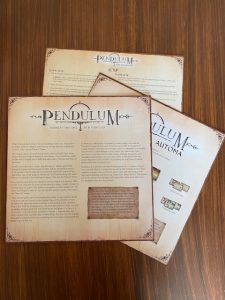 July 10: The Rulebook and the User Interface
July 10: The Rulebook and the User Interface
Pendulum provided some unique playtesting challenges and user interface goals, as we needed every element of the game to be as intuitive as possible during the turnless, simultaneous play. While players can always pause the 3 timers by placing them on their side, we wanted players to simply enter the flow of the game and emerge every 6 minutes for the council phase.
As a result, we paid close attention to how players were interacting with the prototype interface during local and blind playtesting. What mistakes were they making? Which actions were they skipping because they didn’t make sense? Where were we unnecessarily dividing their attention?
One change that emerged from these observations involved player colors. Originally, each character had a certain color associated with it–you chose your character and received meeples and other tokens in their color. But gamers often have a color of choice, and out of habit, we found that people would rather frequently move the wrong meeple, causing a bit of chaos in real time. So we made player colors independent of the characters–you can choose from orange, blue, green, black, and white.
When the game was done, we sent it to the printer and waited for a few months for the pre-production copy (PPC). Typically the PPC is used to make tiny changes at best, but we approached it with fresh eyes, as if we were new to the game. We questioned every element of the final UI and the rules, and we made quite a few revisions. If something wasn’t immediately obvious, we fixed it.
Today I’m excited to share the final results of these efforts. I’ve uploaded the rulebook and the quick reference guide (created by Nersi Nikakhtar). Playthrough videos will be available next week, followed by a Watch It Played rules video later this month. Also next week will be the Automa (solo) rulebook and some Automa-focused design diaries. Happy reading, and have a great weekend!
July 9: Legendary Achievement and Player Interaction
There’s one small but important mechanism/component in Pendulum that I haven’t mentioned: The 10 achievement cards and the metal Legendary Achievement token.
To add a little flavor and variation to each round, there is an achievement card on the board that presents a threshold for any number of players to reach. For example, on the Elite Troops card shown here, to complete the achievement, you need to have at least 6 military, 2 influence, and 3 votes. You don’t spend these resources–you just need to have them.
Once you reach that threshold, you immediately place your achievement marker on the card and either gain the benefit at the bottom or–if you haven’t already gained it this game and it’s still on the card–the legendary achievement token.
This token is the most valuable victory point in the game. There’s only 1 way to get it, and you can’t win without it (it’s the 4th VP row on each character mat). It returns to the newly revealed achievement card at the end of each round.
The achievement cards provide players with short-term goals when they’re looking for something to do. They add a little flavor to the game, and they provide a unique form of player interaction, given the importance of gaining the legendary achievement token once per game.
Originally, the legendary achievement tokens was plastic, but when I received the pre-production copy, it just didn’t feel quite “legendary”. So I made it bigger, sized to fit on the star on the card, and I decided to use metal for it instead of plastic.
That segues into the overall topic of interaction. You’ll see very little “take that” in our games, as we want players to succeed based on their own accomplishments. But we include plenty of different reasons for players to pay attention to each other and opportunities for healthy tension. Here’s the comprehensive list of all of the types of interaction in Pendulum:
–worker placement: The majority of action spaces are limited to 1 regular worker, so you might take an action that another player wants (though they can use their grande worker to step in when necessary). The board is double-sided to provide fewer action spaces for 1-3 players vs 4+ players.
–legendary achievement token: Only 1 player per round can earn this precious VP from the achievement card.
–votes and privilege: You’ll compare your votes each round to other players to determine the new privilege order and the order in which players will select from the limited array of council cards.
–Province cards: These face-up cards are available for any player to pursue–will you get the card you want before someone else?
–timing of timers: When the sand has run out of a timer, any player can flip it. There may be times when you stall a bit while you wait for another worker to become available, or you may flip a timer if you see others stalling.
With all of the core mechanisms revealed, I think I’ll most likely reveal the full rulebook tomorrow and focus on Automa (solo mode) next week. Does that work for you? Oh, and I’ll also show the insert in today’s photos, as there isn’t really much of a story to tell about it (and yes, it fits sleeved cards).
July 8: Engine Building
I absolutely love engine-building in games. Providing a sense of progression is an integral part of the Stonemaier Games design philosophy–we want you to feel much more powerful at the end of the game than at the beginning.
Pendulum showcases engine building in two ways: new stratagem cards and province cards.
One of the resources you can gather in Pendulum is the “vote” resource. Votes represent the support you’ve gained from the Council of Dunya, with whom you’ll meet 4 times during the game (during the untimed phase at the end of each round). At that time, you compare votes gathered that round to your opponents and determine your new privilege order (privilege breaks ties, gives players a bonus based on order, and conveys Council favor).
In privilege order, each player then selects one of the randomly displayed council reward cards. Some of these cards provide instant benefits, but quite a few are new stratagem cards to add to your hand (see the July 7 post about how stratagem cards work).
The bigger element of engine building in Pendulum are the 56 unique Province cards. This is the “conquering” element of the game, in which you’re using your military (a resource in the game) to control more land.
When you gain one of the Province cards–each illustrated by Robert Leask and filtered with a specific color to convey the core purpose of the land–you’ll notice that there’s a benefit on each of the 4 sides of the card. Behind those benefits are colored octagons (with a little dot in a specific corner to avoid colorblind issues). You’ll choose a benefit and then slot the Province card under your character mat so the octagon matches up (see image).
The octagons represent production, so you’ve just expanded your ability to produce something. So if I improved my military (red) production, the next time I take an production action with a worker, I produce both the benefit in the red octagon on my character mat and the benefit on the corresponding card.
Throughout much of playtesting, these cards were actually slotted into a separate mat, but with simultaneous play, dividing players’ attention between multiple mats caused some issues. So we consolidated them into the character mat.
Here are a few insights from Travis about the design process of the Province cards:
“The Province cards in the game also went through their own long cycle of streamlining. Initially there were more on display with their own individual cost in the top corner and a variety of powers or benefits, but they proved difficult for players to process and make effective decisions around. They were the key aspect of engine-building to the game however, so I felt I had to find a way to make them work.
There wasn’t really one big ‘aha!’ moment here though, just a process of continual refinement. One key step was to remove the individual cost on each card and set a universal cost, cutting out one more detail that players had to read on the card. Eventually, they took on a much more standardized format, as they connected to four Production Icons that all players had. Even then, cards still had an immediate one-time benefit in addition to the future production they offered, but players frequently forgot to take the one-time benefit as they agonized over which Production Icon to tuck the card under. So, the immediate benefit had to go. The end result offers players an interesting decision for how to develop their production engine throughout the game with all the superfluous elements streamlined away.”
Do you love engine building as much as I do? What’s a recent game you played that features engine building?
July 7: Points, Winning, and Asymmetry
Winning a game of Pendulum may sound familiar to fans of Euro games: You’re trying to have the most points (after the 4th round). However, there are 4 types of victory points in Pendulum, and you’re only eligible to win if you reach a certain threshold in each point category . The future ruler of Dunya can’t just excel in power, for example–you must also have prestige, popularity, and a notable legendary achievement.
It’s within this VP system that designer Travis Jones added an asymmetric twist: Each character’s track lengths for power, prestige, and popularity are different lengths. So if a character is inherently better at power–indicated by a shorter track–it’s easier to get their power VP token past the threshold (the parchment area on their character mat).
The exact way this works changed throughout the design process; for a while the game was a race to get to that threshold. Now you always play through 4 rounds, and in most games at least one player reaches the threshold with all of their VP tokens. If multiple players do, they look at the points within the parchment area to determine the winner. There are also some edge cases and tiebreakers discussed in the rulebook, which I’ll reveal next week.
Each of the 5 character mats is double sided, with varying track lengths, starting resource, and production abilities on each side. In addition to that asymmetry, each character comes with a starting hand of 4 stratagem cards specific to that character.
These stratagem cards are perhaps my favorite part of Pendulum, because you can play them whenever you want. They give you something to do when you’re waiting for workers on 2-minute and 3-minute actions, and the special bonuses and instant resources they provide can be extremely beneficial. Whenever you want to pull played stratagem cards back to your hand, you just need to pay some culture.
While the asymmetry isn’t extreme in Pendulum, we playtested it with the help of many playtesters around the world to ensure that no character has an advantage over the others.
Travis has a few thoughts about the design process of these characters. Also, if you’d like to sign up for a virtual Gen Con event involving Travis for Pendulum, the schedule is here: https://www.gencon.com/event_finder?search=stonemaier
“Eventually, the design process led me to having unique characters for each player. These had slightly different abilities, but more importantly the characters had different victory conditions in the form of varying lengths to the different Victory Point tracks. At the start of the game players are getting used to executing actions on their own in real-time, which makes formulating a long-term strategy a little more difficult. Having unique characters helps give players some strategic direction right from the start – i.e. players can look down and see that their character’s Power track is the longest, so it would be good to focus on building up their Military production early.
Games with unique characters also signal to players that the game isn’t ‘perfectly solvable’, as each player needs to find their own unique strategy that’s best for their character. This fits well with a real-time strategy game. While I think Pendulum has been developed to minimize any mistakes players can make, there can still be a few small mistakes made here or there (although this can happen in non-real-time games as well). Having different characters means a mistake doesn’t upset some perceived total equality amongst the players.”
From what you’ve seen, which character do you hope to play as first?
July 6: The Teaser Trailer
We typically make a teaser trailer for our new games, and I think it’s time to share the Pendulum video with you! The original script and framework was put together by Joe, revised by me, and then turned into a fancy video by Bryce Walter and his team at We Make Teasers.
There are a few elements in this video that I haven’t explained yet, but I look forward to doing so this week! In the meantime, here’s the next chapter in the story that designer Travis Jones shared with me:
“I was always drawn to the idea of an ‘analog’ real-time game. There’s plenty of amazing things you can do with integrating apps into board games these days, but there’s still something appealing to me about a purely analog game that you could imagine people playing hundreds of years ago just as easily as today. Sand timers aren’t perfect, though. There is always slight variability in manufacturing that results in small runtime differences. A ‘one minute’ timer may end up running five seconds slower or faster.
Other real-time strategy games often have players use sand timers as their personal workers. This is a very clever mechanism, but it does introduce the timers’ variable runtimes as an aspect of the game. Players sometimes end up comparing their timers and complaining that one player has an advantage because their workers are just faster. Some early iterations of Pendulum gave each player one personal timer for their own ‘local’ action row, which introduced this variable runtime factor as well. This led me to eventually fully embrace only having communal timers in the game. Even if some timers have a slightly different runtime than expected, all players are impacted by this equally, so everyone is on even footing.”
July 4: What Your Workers Do and How They Do It
In the July 2 design diary post, I talked about how the sand timers work to create turnless, simultaneous play. Today I’m going to explain what your workers are doing and how they do it.
The image here shows how the board is divided into a few different areas. You can ignore the red and parchment areas for now–they’re not for worker placement. Each of the other areas are mirrored (2 rows of identical worker-placement spaces within each area)–as Travis mentioned in the previous post, there is 1 sand timer assigned to each of those areas, and it flips back and forth between the 2 rows.
You can place workers only on rows where there is no timer. At that point, all you’re doing is placing workers simultaneously with other players, and you’re free to move workers around if you change your mind.
There are some actions where any number of workers can be placed and some where only 1 can be placed, but even on those, each player has a grande worker–just like in Viticulture–that can be placed on an already-occupied action.
When a timer flips to a row of actions with workers on it, the workers are locked into that action. As long as the timer remains there (45 sec, 2 min, or 3 min), you can pay the cost on the arrow (if any) and slide the worker onto the benefit to gain it. Sometimes you’ll have workers on longer actions that you can’t even pay for yet, but you’ll use other workers in the meantime to gain the necessary resources.
The photo here shows a few blue workers on the same action row. The grande worker is on an action that doesn’t have a cost, and the benefit is to gain 1 vote. The regular worker had a cost of 4 military, and it gained a benefit of 1 province card (an engine-building element I’ll discuss soon).
So that’s how worker placement works! Also, I’ve heard a few people ask why we went with plastic meeples instead of wood. I love wood meeples, but we’ve always had difficulties with fumigation laws in Australia (if you import wood into Australia, you’re supposed to fumigate it first). I understand that there are environmental concerns about using plastic, but manufacturing any type of component takes a toll on the environment, and we try to minimize that impact by using recycled materials and by reducing *disposable* plastic as much as possible (shrinkwrap in particular).
I’ll end today’s post with another story from designer Travis about the earliest iterations of Pendulum:
“Besides the inherent challenges to designing a real-time strategy game, Pendulum was also the very first board game I’d designed. The early versions were downright horrible as I worked through my own learning curve on game design. Fortunately, I had some patient friends that stuck with me. Early lessons I had to learn about real-time games, that seem obvious in retrospect, included: you cannot have card text that players have to stop and read, you cannot play for over 10-20 minutes without a break, you cannot have players trying to pay one another a resource, and you cannot have players adjusting other players’ pieces. The first version of the game had all of these in spades, and it was utter chaos.
Despite all of its design flaws, however, those first versions still had some core elements that players were excited about. The gating mechanism and the natural back and forth of the timers meant that even with all the superfluous junk that needed to be trimmed out, players still felt they had a unique level of control over the flow of their own game that they didn’t have in other real-time games. And, of course, no one was ever waiting on another player to take their turn, so everyone felt constantly engaged.
There was plenty of iterating around the number of timers and their length early on as well. While it was great to not have to wait on another player to take their turn, it also wasn’t fun to just be waiting on a timer. This took constant work throughout the design to ensure that players had just enough to think about that they didn’t get bored waiting on timers, but also weren’t too overwhelmed.”
Thanks Travis! And thanks for reading–have a great weekend!
July 2: The Sands of Time
Let’s talk about the elephant in the room: Yes, Pendulum has sand timers. Three of them, to be exact: They’re custom timers designed by Panda Game Manufacturing, and they have run times of 45 seconds, 2 minutes, and 3 minutes.
When I first heard about Pendulum from Design Day attendees, I was curious but hesitant about the “real time” element of the game. If you’re like me, when you hear “real time,” you think about frantic, hectic, stressful moments as the timer ticks down. A race against time. That’s not the case in Pendulum.
I think it’s more accurate to say that Pendulum is “a turnless worker-placement game featuring simultaneous play.” Players are weighing the cost/benefit analysis of placing workers on actions where they’ll remain longer (and get better benefits) versus actions where they’ll be available sooner (and get weaker benefits). That’s why I’ve compared to it to Tzolk’in, one of my favorite games.
Before I yield my time to game designer Travis Jones, who will explain how he came up with this idea and how it’s implemented in Pendulum, a few quick notes:
- The timers are only active during each round, the timed portion of which lasts around 6 minutes, so there are regular breaks in the action.
- Players control when they actually flip the timers. So if you’re not ready to flip a timer, you can just wait until you or someone else is ready.
- If you need to “pause” the game, you can turn the timers on their sides.
- Sand timers can sometimes be off by a few seconds, but this impacts all players equally in Pendulum (opposed to each player having their own sand timer).
- We’ve included a variant in the game that allows you to play without the timers but retain the other mechanisms.
Okay, the rest of this post is by Travis!
I still remember when the original seed of Pendulum was planted. It was after a game day with some friends. We played a couple of heavier strategy games and finished the night with a lengthy game of Ora & Labora. It was a blast, but it took several hours as some of my friends can have really bad ‘AP’ (Analysis Paralysis). For anyone not familiar with the term, it’s when a player takes a really long time on their turn to decide what to do. In the interest of full disclosure, I can be very guilty of this myself. I went to bed with thoughts rattling around in my head of whether you could ever have a deep strategy game experience without having to wait on your friends to take their turns.
My brain must’ve worked on things over night, as I woke up in the morning with thoughts tumbling out of my brain. Obviously, such a game would have to be played in real time. I had played a few real-time games before, but none of them felt like ‘strategy’ games (although they could certainly be fun and exciting in their own way). Something about a clock furiously ticking down to zero just seemed to preclude strategic decision making.
The eureka moment I had that morning was that rather than having a clock that would run out on you, timers could be used purely as a communal gating mechanism for taking actions. This led to having three different sets of action spaces, each with a timer of a different length. Players can choose what actions they wish to take on their own time, and how much time to lock up their various workers for. These choices are all made with players deciding for themselves how much time to spend thinking and planning, so those that want to move at a slower pace are completely free to do so. Time truly becomes just another a resource players are utilizing within the game however they see fit.
The other critical idea from the beginning was the creation of the mirrored rows of action spaces. Players need to flip the timers from one row to another so they can get their worker free or to take an action they want to take. By creating incentives for all players to naturally flip the timers as part of their own actions, the timers effectively regulate themselves with no one needing to watch the last seconds tick away and yell ‘stop!’ at their opponents. This makes time feel like an actual resource you are utilizing along with others in the game, making trade-offs and decisions of how to allocate it, rather than a rush to get to the finish line first.
This all adds up to a real-time game where the goal is not to just play as quickly as possible. Instead, the point of the game is to think about using your time judiciously – sometimes it’s best to make a quick decision, and sometimes it’s best to take time to think. There is no final buzzer you have to beat. The challenge thus becomes to determine when there is value in thinking more about a move and when there is not. The idea behind the game is to prod into this space – how do people decide how to decide? When you can make a choice using instinct or by doing a thorough analysis, how do you decide which approach to use, and how can you get better at choosing the right approach?
There’s actually a whole academic space around ‘decision science’ (which can be a very interesting area to look into, and as a great start I highly recommend Malcolm Gladwell’s 2005 book Blink: The Power of Thinking Without Thinking). And even within board games you can see this in places, for example the game Galaxy Trucker asks players to specifically place a value on the time they spend deciding/planning and going as fast as possible is not always the optimal choice. But, nonetheless, I think it’s an area that hasn’t been explored as fully as it could be, so hopefully, even if just in a small way, this game opens a bit of new space in board gaming.
July 1: Introducing designer Travis Jones and artist Robert Leask
I (Jamey) have a lot of information to reveal about Pendulum over the next few weeks, but I wanted to start by introducing you to two people who you may not have heard of, as they’re making their first entry into the world of published games.
Let’s start with game designer Travis Jones. Like many designers, Travis has designed many games, but Pendulum will be his first published game. He brought Pendulum–then called Heir to the Empire–to the 2017 Stonemaier Games Design Day, an event where people playtest prototypes and share feedback about a variety of games.
The people who playtested the game there loved it so much that the average rating ended up being 9.34–by far the highest rated game in the history of Design Day. Several friends at the event highly suggested that I take a close look at the game, and after I played it, I realized it was something special. I love worker placement and engine building, and I love time/resource optimization. Plus, my interactions with Travis indicated that he was open to feedback and was willing to put in the work to make the game as fun, intuitive, and balanced as possible.
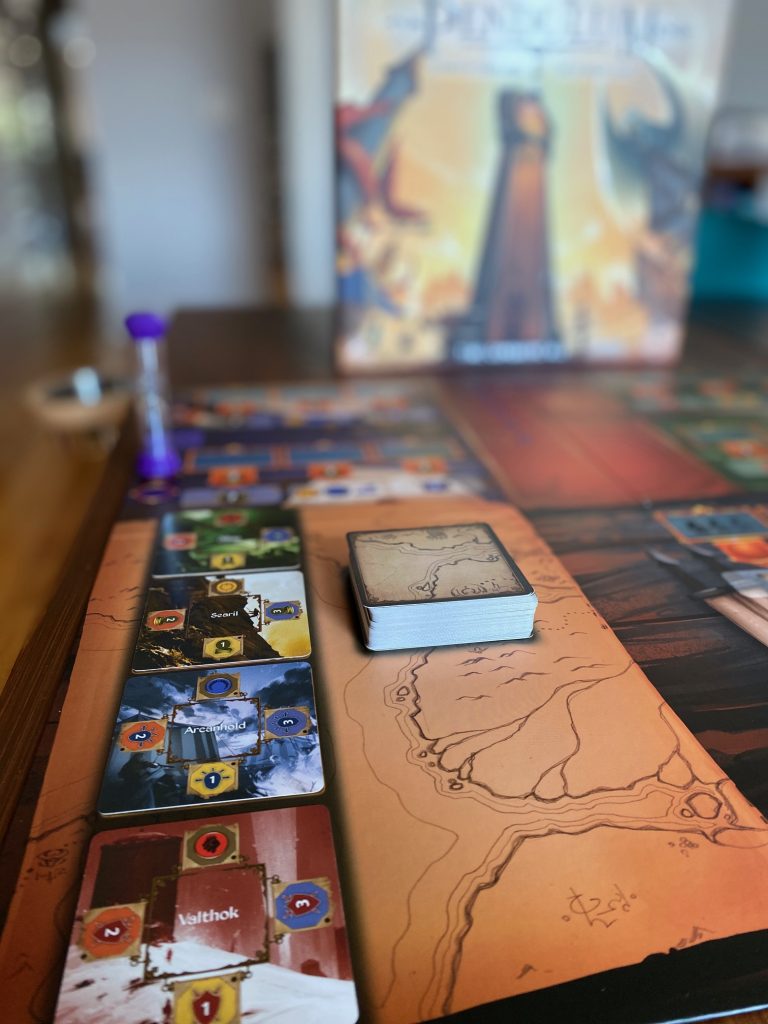
You’ll learn more about Travis soon via some thoughts he’s shared with me about the design process that I’ll post in future design diaries.
The game was originally Roman-themed, but I was hoping to build a new world around the game, a process that Travis was open to. So after we signed the game, I reached out to a few artists who had interest and experience in worldbuilding, and Robert Leask jumped to the top of the list after he submitted information about himself and his portfolio in our open job application form.
Robert spent some time developing the world of Dunya (largely independently, but with input from Travis and myself), and after the foundation was built, he set out to create a vast array of art for the game, with some of my favorite illustrations being those on province cards, character mats, and the game board itself.
It’s actually been a while since Robert wrapped up work on Pendulum, and it’s neat to see that he continues to grow as an artist. I’d recommend checking out his Facebook page to see what he’s been creating recently.
There are many other people who were involved in the creation of Pendulum, but I’m happy to shine the spotlight on these two today, as the game wouldn’t exist without them. Both Travis and Robert will be available as part of a Meeplesource-coordinated panel at virtual Gen Con–stayed tuned for more information about that.
I’ll be back tomorrow with some information about how Pendulum actually plays!
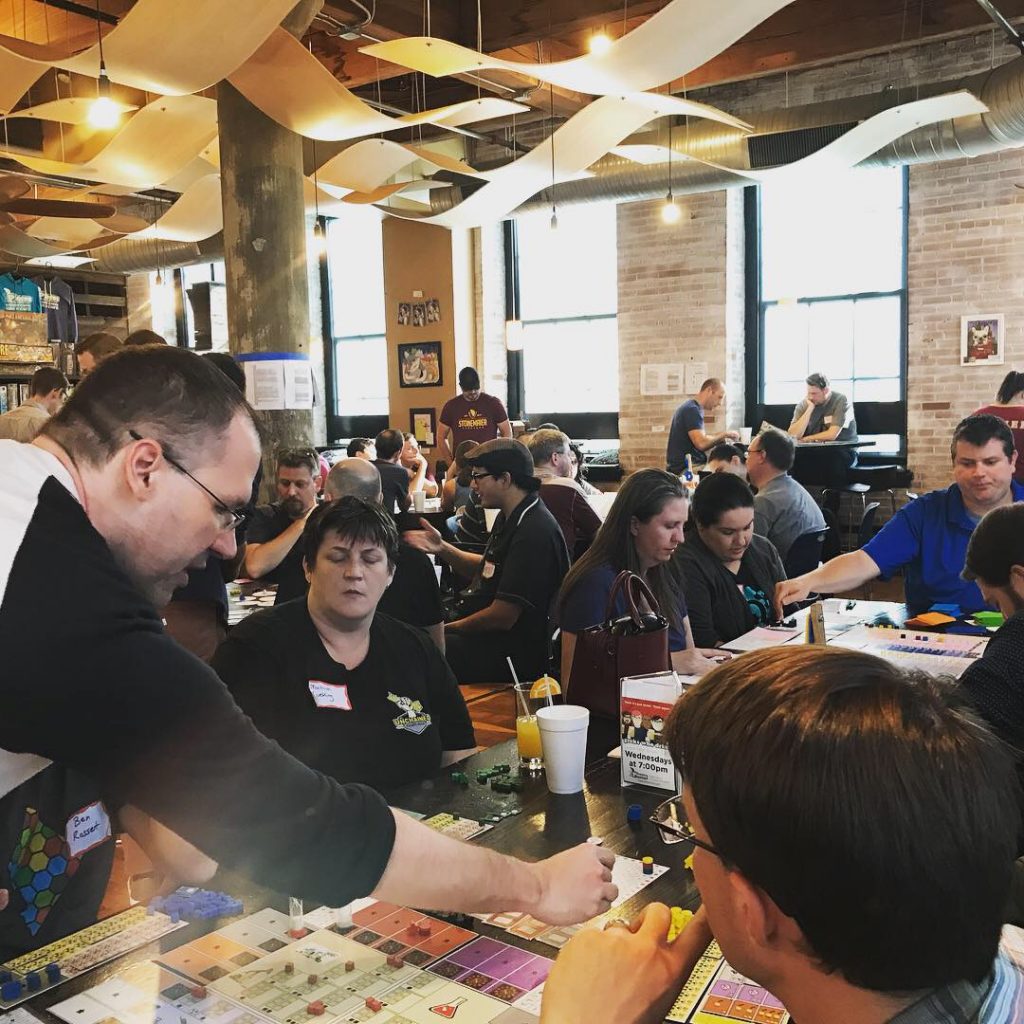
32 Comments on “Design Diary”
Leave a Comment
If you ask a question about a specific card or ability, please type the exact text in your comment to help facilitate a speedy and precise answer.
Your comment may take a few minutes to publish. Antagonistic, rude, or degrading comments will be removed. Thank you.
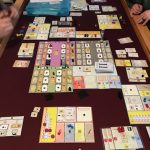


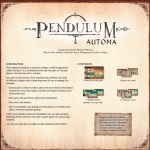
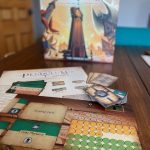
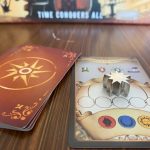
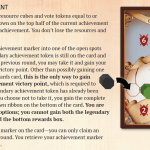

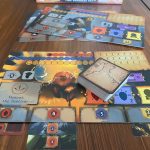
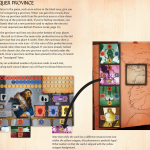
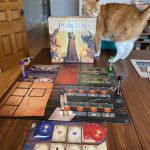
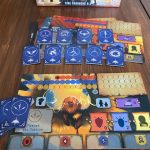
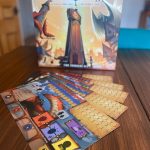
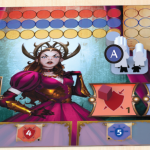
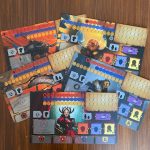
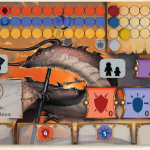
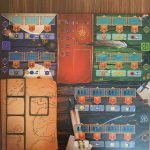
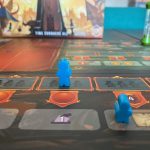


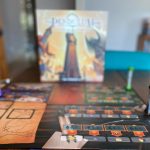
We are very excited by this game and can’t wait for preorders to open. Our whole family are big Stonemaier fans, and this looks like another lovely addition to our collection.
I just have one quick question about the Legendary Achievement. Since there are only four rounds it would appear that in a 5 player game there will always be one player who cannot have a chance at winning as there aren’t enough rounds for every player to successfully get that marker. So even if a player has all of their tracks into the parchment, they would lose to other players who potentially didn’t. It puts a pressure on all players in a 5 player game that isn’t there at other player counts since in every other player count there is the ability for all players to end up with that achievement by the end of the game since every player can only achieve it once per game.
Just curious if this is an accurate reading of the rule book, I definitely could have missed something so I thought I would ask. :)
Ali: Thanks for your question. There is actually one backup way I forgot to mention for a player to get the Legendary Achievement in the last round (there’s a specific set of council reward cards used for the last round). But yes, the pressure is there throughout the game to get that token! :)
Are the different resource+vp-track combinations really different “strategic pathways”? Since you have to complete all the tracks to win, it doesn’t really seem like you could spend one game trying “the popularity strategy” and another game playing “the power strategy”, you’ve always got to do them both, although you might have to do one or the other more heavily depending on your character.
The different strategic paths look more to me like….”focus on provinces first” vs “focus on more workers first”, or maybe “focus on playing and recycling your strategem cards.”
If I’m playing Pendulum and I have a long military track to complete and a short popularity track, it will definitely impact the decisions I make and the engine I build.
A quick question: if a player wins the legendary achievement multiple times, can they shut another player out of the possibility of winning the game?
Steve: No, it’s not possible to gain the token more than once. Here’s the paragraph in the design diary that emphasizes this:
“Once you reach that threshold, you immediately place your achievement marker on the card and either gain the benefit at the bottom or–if you haven’t already gained it this game and it’s still on the card–the legendary achievement token.”
Jamie: Thanks for the clarification. Somehow I put this statement together with the statement that says you can’t win without having a legendary achievement, and mistakenly thought they resulted in the possibility of a player potentially being unable to win if they weren’t fast enough or were consistently in the wrong privilege order. Can’t wait to play it!
I hate when games have character colors. I prefer playing yellow, so I’ve gotten very used to moving the yellow pieces. As you can imagine in a game where I have the red character and someone else has the yellow character; I always move the yellow pieces for the first couple of turns till my brain makes the adjustment.
So what happens if multiple players meet the achievement card’s requirements at the start of the round?
If both of those players want the legendary achievement token, as with everything else in the game, ties are broken by privilege order.
I would also note – it is impossible for multiple players to qualify at the start of the round because each council phase your votes are reset to 0, and every Achievement card requires 3 votes. So, players will only meet the requirement at some point later in the middle of the round.
What I love about Stonemaier games is that there is always some wonderful component that I enjoy manipulating. Like the mechs and dual layered player board in scythe, the eggs in Wingspan, etc. I assume this is a purposeful production decision and so I was curious what that “hook” is for Pendulum? The sand timers certainly look very cool. But doesn’t seem like you get to manipulate it that often.
In Pendulum, the component hooks are the custom sand timers, the frosted character mats, and one small component I’ll reveal tomorrow.
So if the strategy cards are playable any time and are recoverable for culture, does that mean the cards effectively define a conversion rate for culture to other resources? Or are we talking trickier effects than just gaining some resources (effects that are too tricky seem like they would be a problem in simultaneous play)?
Not necessarily tricky, but often better than the standard conversion rates on the board. Or just easier since you can play them whenever you want.
In the teaser video, at 0:42, the right center faction mat is reversed. Is that the reverse faction, or an error?
Just a mistake in the video edit. Good eye!
@Jamey: Ever since I tried to play my Tamsk after not having played it for ten+ years, I’m worried about hour glasses in games. The Tamsk hour glasses simply didn’t work [properly] anymore. Probably because moisture had krept into them, due to subpar manufacturing. I’m looking forward to Pendulum, but can you reassure us gamers that these hour glasses are really well manufactured (and will last the test of time)?
Jan: While I can’t guarantee that every sand timer will work perfectly, we tested all of the samples Panda sent us, and they tested their design extensively before they made them for us. Of course, however, if your timers stop functioning, we’ll be here with replacement parts to help. :)
It looks the circles beside the action slots is where the timer sits. And I understand that there are 3 timers, one for each colour. But why is there two circles beside the purple action slot on the top left? Since there’s only one purple sand timer. just curious. I’m sure it’ll be answered eventually.
Niranjan: Great question! The purple spaces for the timer are used to determine the length of each round (the timer bounces around between them).
This seems like it still has opportunities for timing conflicts–non-identical single-worker spaces exist, therefore two players who need the resource might both want to jump on the space as soon as it frees up. How do conflicts like that get resolved in a way that succeeds in the “doesn’t advantage the quickest / isn’t frantic” stated goal?
The grande worker might reduce how often the conflict is critical but wouldn’t remove them entirely.
It seems to happen quite rarely, as each player develops a rhythm that is unique to them. However, in the rare cases where two players attempt to place a worker at the same moment, there is a “privilege” mechanism that decides which player gets to use the action.
I find myself worried that playing nicely in that way will be….group-specific.
I remember playing this at Design Day and sharing with Travis, “you HAVE to publish this game.” I’m really excited that Stonemaier has picked this up. Y’all gotta get this game and give it a spin. I’ll be first in line to get my copy. Congrats to Travis on his first published game!
Thanks, Joe! Enjoyed playing with you!
Doesn’t the word Dunya itself mean world?
I believe the artist/worldbuilder chose that word from Turkish meaning “world.” You’re right. :)
Jamey, thanks for the update about Pendulum. I can’t wait to get my hands on this game! My 13-year-old son and I are creating our first board game and it’s been a great activity/journey during COVID-19 for the both of us. The Design Day sounds like an awesome event, and a great way to introduce a new game to so many new play testers. Is this something Stonemaier continues to do each year? If so, is this something that’s open to the public or do you need an invite?
Thanks again for your transparency and connection to the community. We love so many of your games and you’ve definitely inspired us to create one of our own.
Indeed, we do it every year! We’re sold out for this year, but you can get on the waiting list (and get an early invitation next year) here: https://stonemaier-games.myshopify.com/products/stonemaier-games-design-day-2020?variant=30242233122897
Is the idea of having a unique world one of Stonemaier’s philosophies, or did that simply work better for this game in particular. With Scythe and Tapestry specifically, it seems like it would be the former rather than the latter.
It depends on the game. Our core philosophy is to make games that capture your imagination, and while that’s possible with games set in the real world (like Wingspan, Viticulture, and our Between Two series), I think it’s also a lot of fun to venture into other worlds (Euphoria, Scythe, Charterstone, Pendulum, etc). And sometimes it’s fun to let players build their own worlds and histories, like in Tapestry. :)